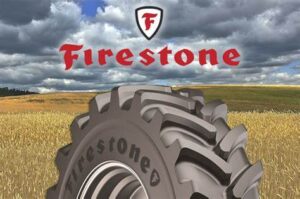How agricultural tire design helps maximize tire life and operator comfort
Nashville, TN – As farms grow and fields get farther apart, farm equipment—especially tractors—spend more time on the road. Getting from field to field smoothly and quickly is crucial for productivity. Choosing tires that match your operation’s in-field and on-road needs ensures safe, efficient and comfortable road travel while maintaining performance in the field.
“Tire designs are evolving to include features that enhance the tire’s ability to perform at higher speeds and across a range of conditions,” says Bill Durivage, senior agricultural product strategy manager, Firestone Ag. “These features make tires more reliable and versatile for all types of farm operations.” Tire manufacturers engineer and then test tires to verify they can perform in a range of conditions and under the stresses of daily operations.
Choosing the right tire is the key to finding the right balance between comfort and safety on the road and traction and efficiency in the field. Understanding tire design is the first step in choosing tires that fit your operation and helps ensure you get the most from your investment.
The importance of choosing tires designed for road travel
There are many reasons to equip your tractors and other farm equipment with tires appropriate for the type of travel you do. Operating tires not intended for frequent road travel can impact operator safety and ride comfort, machine performance, tire wear and tire lifespan.
Extend tire life: Frequent and lengthy on-road travel impacts tire wear life. Road-optimized tires are designed to travel without experiencing excessive or rapid wear.
Avoid early replacement: Tires designed for frequent road use are built to run at higher speeds. Faster speeds generate more heat. Operating a tractor tire beyond its speed rating generates excessive heat, which can lead to damage to the tread lugs and separations within the tire casing.
Improve steering control: Tires with a smoother-running tread pattern provide better steering control because they create more consistent contact with the ground.
Increase ride comfort: When a tire is not designed for road use, the operator may experience increased bouncing and vibrations. As a result, the ride from the cab will be rougher and less enjoyable, leading to driver fatigue.
How design influences on-road travel, speed and longevity
Road-optimized tires, like Bridgestone tractor tires, are designed to deliver long-lasting wear on the road while preserving a comfortable and smooth ride regardless of the terrain. Advances in tread patterns, sidewall construction and rubber compounds enable them to do this.
Tread patterns impact a tire’s contact with the road, influencing tire vibration and ride smoothness. A tire with an optimized tread pattern balances grip and smoothness, ensuring traction in the field and comfort on the road. Additionally, the design and arrangement of tread lugs affect how a tire wears over time. An optimized tread pattern promotes even wear at higher road speeds, increasing the tire’s lifespan.
Tread volume, or how much rubber is in the tread, can dictate how much life you get from your tires. When a tire is designed for road travel, it has a higher tread volume and thus a longer wear life.
Sidewall construction of the tire directly affects the tire’s strength, flexibility and thus its durability. A strong, well-engineered sidewall offers more stability on the road while managing the high stress and strain of deflection effectively. This helps the tire provide proper suspension, move smoothly on any terrain, and cushion the impact on the road surface.
Advanced rubber compounds in modern tractor tires resist heat build-up without compromising durability, helping the tire maintain integrity even under high stress. New advancements in tire material provide excellent wear resistance and stubble protection, helping make tires more durable and long-lasting.
“By incorporating advanced features, road-optimized tractor tires balance durability, performance and comfort,” says Durivage. “This ensures farmers can rely on their tires for long-lasting wear and smooth rides across any terrain.”
Boost tire longevity with proper inflation
Maintaining the right inflation pressure needed to carry the load is also important when traveling on the road. Correct inflation pressure helps maintain traction, reduces excessive heat generation and prevents irregular tire wear.
Operating overinflated tires may cause excessive and irregular wear in the tread center, resulting in a harsher ride. Underinflated tires can decrease machine stability, increase fuel use and expedite tire wear.
Regular maintenance is also key to optimal tire performance. This includes keeping tires properly inflated, checking for signs of wear, and ensuring they are used within their rated load and speed limits. Following these practices allows you to maximize the lifespan of your tires and reduce the risk of costly downtime and repairs.
The balancing act of picking the right tire
It is all about your application. Consider how much time you spend in the field, on the road, and your highest load scenario. Just like your equipment should match your needs, so too should your tires.
“Remember, it is a balancing act,” says Durivage. “If you’re running on the road a lot, you need a tire that provides comfort and ride smoothness on the road but also traction where it truly matters, in the field.”

